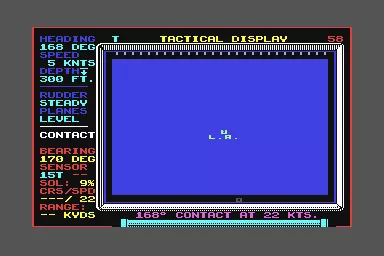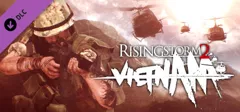Red Storm Rising
Description official descriptions
The Soviet Union, under severe pressure after destruction of one of their biggest oil refineries, must secure a new source of oil, and to do that, they must disable the West... which means they must invade Europe and fight NATO to a standstill... And the only way NATO can prevent that from happening is to reinforce their forces with convoys from the US and other countries.
You are in command of one of the US attack submarines. You must hold the ocean against the Soviet navy at all costs, or the land battle will go badly. Part submarine simulator, part dynamic campaign, and part WW3 simulation, Red Storm Rising is an amazing look at modern warfare.
Groups +
Screenshots
Promos
Credits (Commodore 64 version)
24 People · View all
| Game Design | |
| Original C-64 Programming | |
| Computer Graphics | |
| Music & Sound Effects | |
| Manual Text | |
| Manual Graphics | |
| Technical Advice & Research | |
| Quality Assurance | |
| Playtesting | |
| [ full credits ] | |
Reviews
Critics
Average score: 80% (based on 19 ratings)
Players
Average score: 3.8 out of 5 (based on 32 ratings with 4 reviews)
The Good
If I was to rate my best games by how many hours spent playing, the only games that could beat this title would be Civ I and Civ II !!! However if you look at the game now it is very dated but when it came out this was so far above anything out there. While most kids were jumping mario around I was making the world safe for democracy.
In very very very very few games has the gameplay been simple and easy to learn but yet still capture your attention. This game could do that in a heart beat. It only took a few moments to get the feel for how things worked and when you did there was so much you could learn and do. This game is one of the reasons why I often think back to the old days of PC gaming and smile. :-)
The Bad
It ended.
The Bottom Line
Unfortunately I can not recommend this great game to just anyone. You have to love gaming to play this title. You have to understand what it felt like to only have Pac Man as a option when you wanted to play a game. You have to feel the pain as you realize that that new game on the shelf that you want so badly will only work on a 486 and you have a tandy 286. Yes you have to really love old dusty games to gather the true beauty........ Who am I kidding just play it :-)
DOS · by William Shawn McDonie (1131) · 2001
The Good
The agony...
The Bad
Its box was small! :-P
The Bottom Line
This submarine simulation is one of Sid Meier’s less known endeavors. It is based on the best-selling novel Red Storm Rising, Tom Clancy’s depiction of a hypothetical World War III. We take the role of a NATO nuclear submarine commander and we operate against the Soviet Union.
Although in the technical field the game is utterly surpassed, there are a few things that deserve mentioning. First of all, the graphics somehow manage to grasp the anguishing and claustrophobic environment of undersea warfare. They definitely give us the feeling of being there and doing something important. All of the submarine’s data and functions are clearly and neatly presented. Also, when our weapons reach their target, either hitting it or getting destroyed by it, we are informed through graphical sequences. Finally, there are some convincing sounds for several aspects of the game.
After we set the time period and enter our commander’s name, we choose our submarine’s type. There are also four available levels of difficulty. They start from average and reach almost inhuman standards. Finally, we get to select between training courses and scenarios with battles against fleets containing submarines, ships and helicopters. Medals and promotions reward exceptional results.
The game can boast about its excellent playing highlight, the all-out war with the USSR. There, with a map of the northern seas in front of us, we start from our base in the Scottish port of Holy Loch for missions in the East Atlantic, the Norwegian, Greenland and Barents Sea. Our performance in these missions will determine the very outcome of the war. Every now and then, climate-boosting intermissions inform us on important political and military events. During the campaign we will have to inflict the highest possible damage to enemy task forces, convoys and land targets. Time is of the essence here, quick and decisive actions are of paramount importance. Swift reaching of the mission objectives, stealthy movement and quick trips to Holy Loch for repairs and rearmament are greatly significant to the war effort. One should first prepare adequately in the solitary missions, before entering the exciting and challenging environment of the campaign.
Like in the vast majority of Microprose’s titles, realism is a high priority. The player has to involve with many different and demanding activities. He has to learn how to silently trace the enemy and surprisingly engage him, how to use his ordnance wisely and effectively. Torpedo evasion is something that takes time in order to be done efficiently, and without neglecting the tactical situation of the battle. Finally, deep familiarization with all the ship’s sensors, menus and controls is crucial, because only through their intensive use we will achieve our goals. The fact that numerous keys are needed for playing can initially be a shock to the unaccustomed. The game was accompanied by a sizeable documentation that covers all necessary issues in great detail. A deep study of the manual is useful for a complete playing experience.
Recommended mostly to the determined friends of the genre, “Red Storm Rising” offers hours of highly satisfying involvement. The rest are kindly requested to keep their distance and watch “The Hunt for Red October” instead.
DOS · by Iron Lord (40) · 2016
Still the standard for submarine simulations
The Good
Dynamic campaign, wide variety of enemies to fight, huge terrain, multiple submarines to play (Permit, 688, 688 improved, and Seawolf), plenty of weapons (Harpoon, Sea Lance, Tomahawk Antiship, Tomahawk Cruise, Mk 48, Mk 48 ADCAP, Stinger mast), intricate torpedo control, tie-in with the novel...
The Bad
No 3D view, no true water-fall sonar display, no manual classification of sonar signals, no TMA analysis...
The Bottom Line
The classic Red Storm Rising has held up well over the years as still the submarine warfare sim to beat. While Jane's 688(i) Hunter/Killer is a better SUBMARINE sim with better sonar and TMA simulation, Red Storm Rising has dynamic campaign and a much wider set of enemies, as well as multiple submarines, more weapons, and more weapon control. RSR is a true classic looking for a remake.
DOS · by Kasey Chang (4579) · 2000
Trivia
Cancelled Spectrum version
All 3 of the UK's major Spectrum magazines (Sinclair User, Crash! and Your Sinclair) mentioned (over an 18-month period) that a Spectrum version was due, but there's no evidence of it having been finished or released.
Inaccuracies
Most people know that in *our* universe, history recorded the collapse of the Soviet Union in August 1991. Therefore, a few of the weapons that are described in the game as eventually becoming available to the US, were weapons that never became available in real life -- both because it seemed the major threat had disappeared, and because the absence of that threat made it it harder to persuade people to spend money on these expensive weapon systems.
• The Sea Lance program, including the version that carried a Mark 50 torpedo, was cancelled in 1990. Some were built, but none ever entered service. Its other version would have replaced the existing ASROC and would have carried a nuclear depth charge, but these were never even built.
• So far, the US has never had a system to fire anti-aircraft missiles out of a magazine in the "sail" (conning tower) of a submarine, and there has never been any magazine there for them to come out of, much less one that could hold twelve shots. At a guess, the most likely explanation would be that when this game was made, such a system was projected for the future. The British once ran experiments with a single-shot version of this idea, though -- it fired the Blowpipe missile, which was like the Stinger, but much older and cruder.
All of the other weapons systems, including all the upgrades to the Mark 48 ADCAP torpedo, happened the same in real life as they did in the game.
Time periods
The game actually has FOUR mode, theorizing the the actual time of the conflict. The book was written with the technology of 1988, but you can play the game in 1984, 1988, 1992, or 1996 respectively, with different orders of battle.
While based on the submarine ops in the novel, the game actually lets you play out the naval conflict both BEFORE the novel's date (about 1984), which affects equipment availability for both sides. For example, in 1980 US mainly has older subs, but the Soviets haven't gotten any of the "stolen" tech yet. By 1988 and 1992 newer US technology like Tomahawk missiles and Sea Lance torpedo came into service, but Soviet navy grew and their latest subs are MUCH quieter.
In 1988, the Russian SIERRA and KILO subs enter service, and more ships get tech upgrades. The US gets Tomahawk missile and the Mk48 ADCAP torpedo.
In 1992, the Russians gets the Kuznetzov nuclear aircraft carrier with more tech upgrades for the other ships. The US gets Sea Lance AWS missile and Stinger SAM mast.
In 1996, almost all Russian ships get tech upgrades, and they also get more ships. For the NATO side, the Seawolf-class sub enters service with the silent "swim-out" Mk. 48 torpedo.
Awards
- Amiga Joker
- Issue 01/1991 – #4 Best Simulation Game in 1990
- Amiga Power
- May 1991 (issue #00) - #98 in the "All Time Top 100 Amiga Games"
- Computer Gaming World
- November 1996 (15th anniversary issue) – #39 in the “150 Best Games of All Time” list
- November 1996 (15th anniversary issue) – #8 Most Rewarding Ending of All Time
Information also contributed by 88 49, Martin Smith and PCGamer77
Analytics
Identifiers +
Contribute
Are you familiar with this game? Help document and preserve this entry in video game history! If your contribution is approved, you will earn points and be credited as a contributor.
Contributors to this Entry
Game added by Shawn McDonie.
Amiga added by Rebound Boy. Atari ST added by 80. Commodore 64 added by William Shawn McDonie. PC-98 added by Terok Nor.
Additional contributors: Kasey Chang, Patrick Bregger, Jo ST.
Game added June 16, 2000. Last modified February 25, 2025.






















